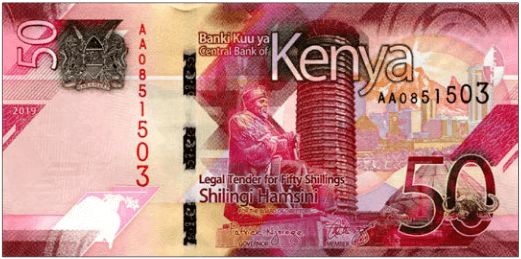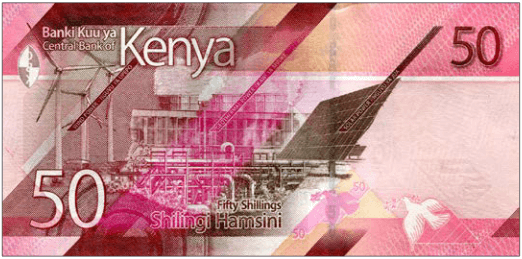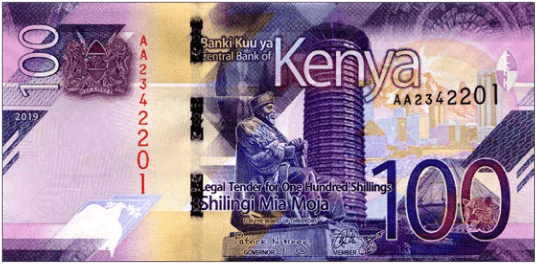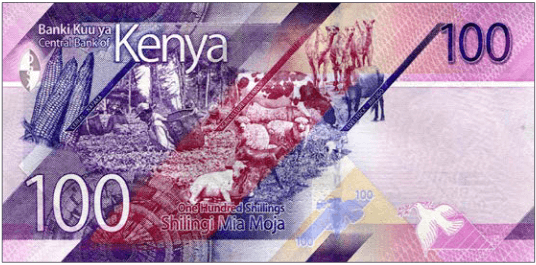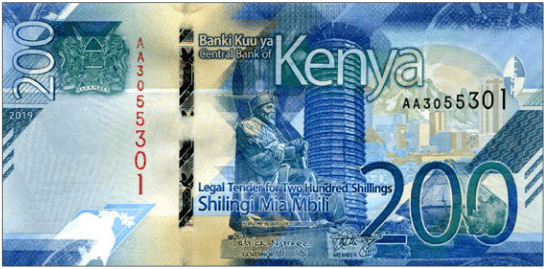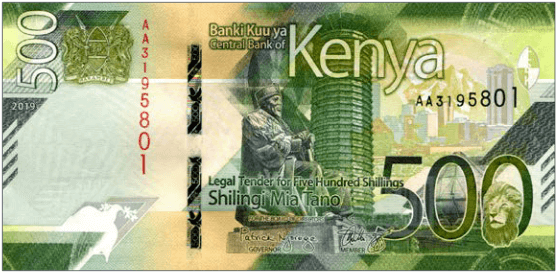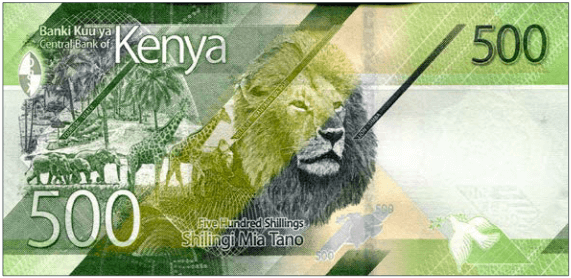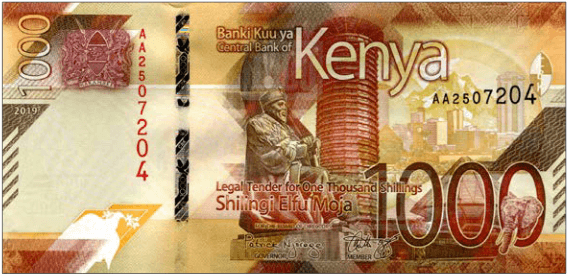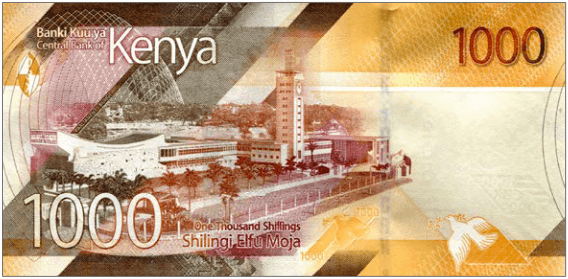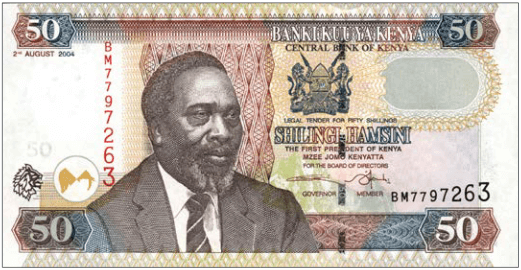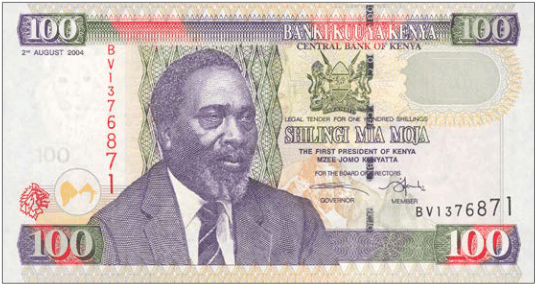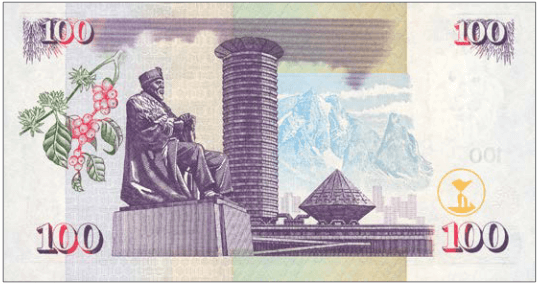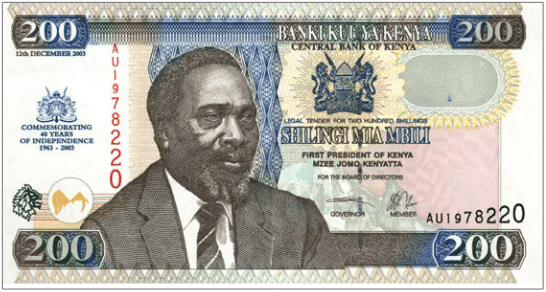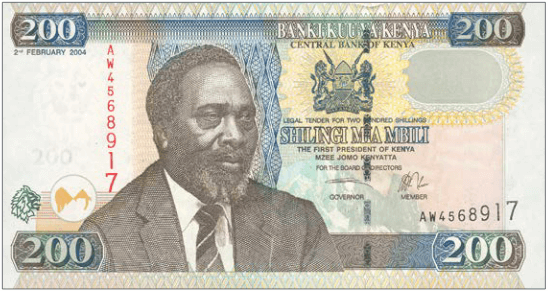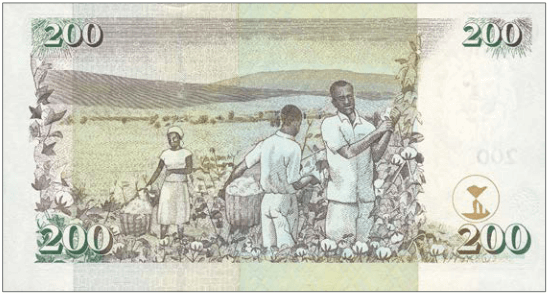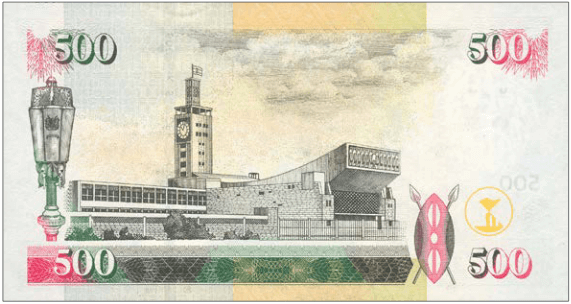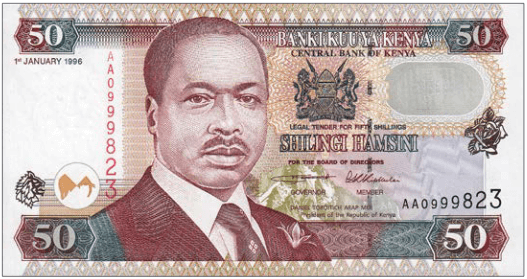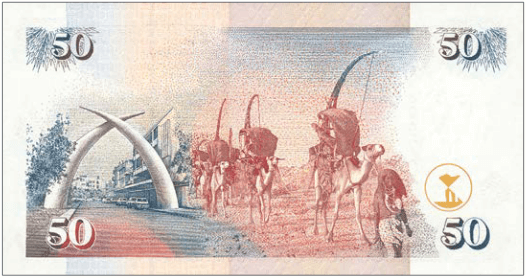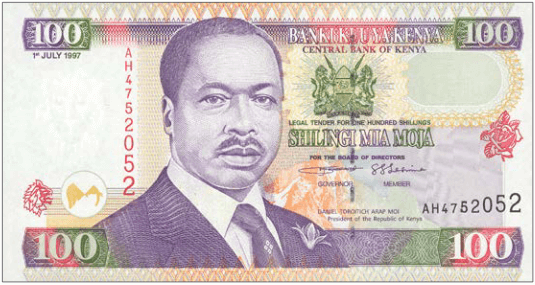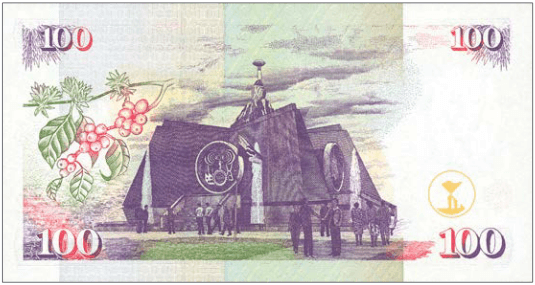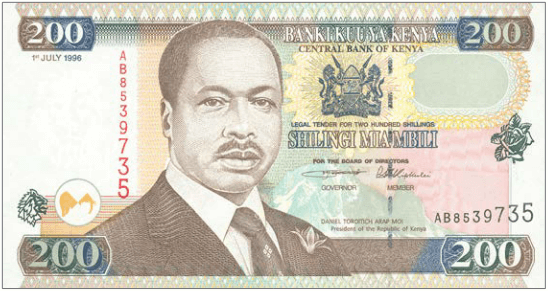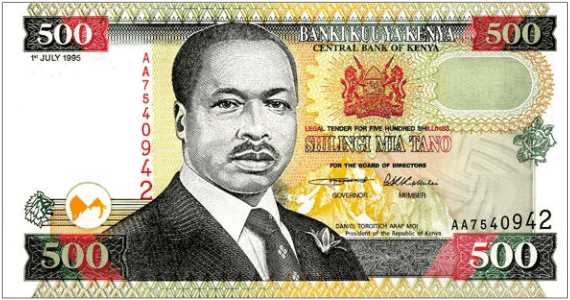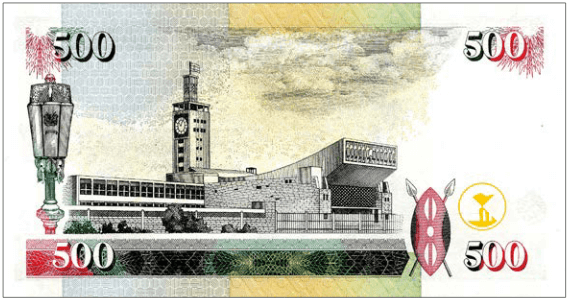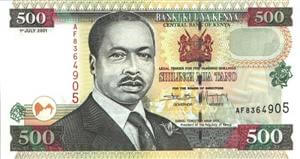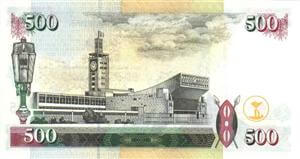KES – Kenyan Shilling
Monetary System
14.09.1966: 1 Kenyan shilling (KES) = 100 cents
Central Bank of Kenya
The Central Bank of Kenya (CBK) was established through the Central Bank of Kenya Act of 1966, a direct result of the desire among the three East African states—Kenya, Tanganyika (Tanzania), and Uganda—to have independent monetary and financial policies. This led to the collapse of the East Africa Currency Board (EACB) in the mid-1960s.
For more information, visit www.centralbank.go.ke.
2019 Issues
All of these new notes bear the image of Kenyatta International Conference Centre. The banknotes also embody each of the big five: buffalo, leopard, rhinoceros, lion, and elephant. Each banknote has a unique theme to show the richness of the people and nature in Kenya (50 shillings, Green Energy; 100 shillings, Agriculture; 200 shilling, Social Services; 500 shillings, Tourism; 1,000 shillings, Governance).
Each note has a 7-digit serial number and 2-letter prefix. The prefixes start at AA, and the second letter advances alphabetically over time.
Description: 50.00 KES – Kenyan Shilling Size: 124 x 62 mm
Red. Front: English and Kiswahili text; coat of arms; flying dove as registration device; Kenyatta International Conference Centre in Nairobi with seated Kenyatta statue and tower and amphitheater buildings; Mount Kenya; bank monogram as registration device; buffalo. Back: English and Kiswahili text; bank monogram; wind farms at Loyangalani; geothermal electricity production at Olkaria; solar power panels; flying dove. Kenya strives for a cleaner world. Red-to-green windowed security thread with demetalized bird and CBK 50. Watermark: Lion head, electrotype CBK / 50, and Cornerstones. Printer: (De La Rue). 124 x 62 mm. Paper.
Description: 100.00 KES – Kenyan Shilling Size: 128 x 64 mm
Purple. Front: English and Kiswahili text; coat of arms; flying dove as registration device; Kenyatta International Conference Centre in Nairobi with seated Kenyatta statue and tower and amphitheater buildings; Mount Kenya; bank monogram as registration device; leopard. Back: English and Kiswahili text; bank monogram; corn cobs; tea leaf harvesting; livestock rearing; flying dove. Red-to-green windowed security thread with demetalized bird and CBK 100. Watermark: Lion head, electrotype CBK / 100, and Cornerstones. Printer: (De La Rue). 128 x 64 mm. Paper.
Description: 200.00 KES – Kenyan Shilling Size: 132 x 66 mm
Blue. Front: English and Kiswahili text; coat of arms; flying dove as registration device; Kenyatta International Conference Centre in Nairobi with seated Kenyatta statue and tower and amphitheater buildings; Mount Kenya; bank monogram as registration device; rhinoceros. Back: English and Kiswahili text; woman holding child being examined by doctor with stethoscope; man teaching children to use laptop computers; four competitive runners holding Kenyan flag; flying dove. Red-to-green and rainbow windowed security thread with demetalized bird and CBK 200. Watermark: Lion head, electrotype CBK / 200, and Cornerstones. Printer: (De La Rue). 132 x 66 mm. Paper.
Description: 500.00 KES – Kenyan Shilling Size: 138 x 68 mm
Green. Front: English and Kiswahili text; coat of arms; flying dove as registration device; Kenyatta International Conference Centre in Nairobi with seated Kenyatta statue and tower and amphitheater buildings; Mount Kenya; bank monogram as registration device; lion. Back: English and Kiswahili text; palm trees, elephants, and giraffes in Maasai Mara park; lion head; flying dove. Red-to-green and rainbow windowed security thread with demetalized bird and CBK 500. Watermark: Lion head, electrotype CBK / 500, and Cornerstones. Printer: (De La Rue). 138 x 68 mm. Paper.
Description: 1,000.00 KES – Kenyan Shilling Size: 142 x 70 mm
Brown. Front: English and Kiswahili text; coat of arms; flying dove as registration device; Kenyatta International Conference Centre in Nairobi with seated Kenyatta statue and tower and amphitheater buildings; Mount Kenya; bank monogram as registration device; elephant. Back: English and Kiswahili text; Parliament building and clock tower in Nairobi; flying dove. Red-to-green and rainbow windowed security thread with demetalized bird and CBK 1000. Watermark: Lion head, electrotype CBK / 1000, and Cornerstones. Printer: (De La Rue). 142 x 70 mm. Paper.
2003 – 2010 Issues
After Mwai Kibaki replaced Daniel Toroitich Arap Moi as president on 30 December 2002, a new series of notes with the old portrait of Mzee Jomo Kenyatta was introduced.
These notes have prefixes that resume where the preceding issues end.
Description: 50.00 KES – Kenyan Shilling Size: 138 x 72 mm
Brown and maroon. Front: English and Kiswahili text; lion; elephant as registration device; first president, Mzee Jomo Kenyatta; Mount Kenya; coat of arms. Back: Mombasa Tusks monument with buildings and cars on Moi Avenue leading to Kilindini harbor; camel caravan. Windowed security thread with demetalized CBK 50. Watermark: Varieties. Printer: (De La Rue). 138 x 72 mm. Paper.
Description: 100.00 KES – Kenyan Shilling Size: 140 x 74 mm
Purple, green, and red. Front: English and Kiswahili text; lion; elephant as registration device; first president, Mzee Jomo Kenyatta; Mount Kenya; coat of arms. Back: Coffee berries; Kenyatta International Conference Centre in Nairobi with seated Kenyatta statue and tower and amphitheater buildings; Mount Kenya. Windowed security thread with demetalized CBK 100. Watermark: Varieties. Printer: (De La Rue). 140 x 74 mm. Paper.
Description: 200.00 KES – Kenyan Shilling Size: 142 x 75 mm
Brown and green. Front: English and Kiswahili text; lion; elephant as registration device: Overprint; lion; first president, Mzee Jomo Kenyatta; Mount Kenya; coat of arms. Back: Kiswahili text; woman and two men picking cotton; overprint. Windowed security thread with demetalized CBK 200. Watermark: Lion head. Printer: (De La Rue). 142 x 75 mm. Paper.
This commemorative note is similar to the 200-shilling notes which followed, but it has a thinner security thread, no electrotype watermark, and an overprint of the coat of arms and COMMEMORATING 40 YEARS OF INDEPENDENCE 1963 – 2003 over the watermark area on front, and KUADHIMISHA MIAKA ARUBAINI YA UHURU 1963 – 2003on back. The date on the note is Kenya’s Independence Day.
Description: 200.00 KES – Kenyan Shilling Size: 142 x 75 mm
Brown and green. Front: English and Kiswahili text; lion; elephant as registration device; first president, Mzee Jomo Kenyatta; Mount Kenya; coat of arms. Back: Woman and two men picking cotton. Windowed security thread with demetalized CBK 200. Watermark: Varieties. Printer: (De La Rue). 142 x 75 mm. Paper.
Description: 500.00 KES – Kenyan Shilling Size: 147 x 78 mm
Black, yellow, and green. Front: English and Kiswahili text; lion; elephant as registration device; first president, Mzee Jomo Kenyatta; Mount Kenya; coat of arms. Back: Parliamentary mace; Parliament building and clock tower in Nairobi; shield and spears. Windowed security thread with demetalized CBK 500. Watermark: Varieties. Printer: (De La Rue). 147 x 78 mm. Paper.
1994 – 2002 Issues
The new notes introduced in 1994 are smaller in size than the preceding issues. The new portrait of President Moi is flanked on the right by Mount Kenya, and on the left by a lion and an elephant as registration device. These notes also use novel serial numbering for the first time. These and all subsequent notes are confirmed printed at the De La Rue plant at Ruaraka, Nairobi.
Each note has a 7-digit serial number and 2-letter prefix. The prefixes start at AA, and the second letter advances alphabetically over time before advancing the first letter. New date and signature varieties have prefixes that resume where the preceding varieties end.
Description: 50.00 KES – Kenyan Shilling Size: 138 x 72 mm
Brown and maroon. Front: English and Kiswahili text; lion; elephant as registration device; second president, Daniel Toroitich Arap Moi; Mount Kenya; coat of arms; rose. Back: Mombasa Tusks monument with buildings and cars on Moi Avenue leading to Kilindini harbor; camel caravan. Windowed security thread with demetalized CBK 50. Watermark: Lion head. Printer: (De La Rue). 138 x 72 mm. Paper.
Description: 100.00 KES – Kenyan Shilling Size: 140 x 74 mm
Purple, green, and red. Front: English and Kiswahili text; lion; elephant as registration device; second president, Daniel Toroitich Arap Moi; Mount Kenya; coat of arms; rose. Back: Coffee berries; Kenya Uhuru (“Freedom” in Kiswahili) Monument in Uhuru Park, Nairobi. Windowed security thread with demetalized CBK 100. Watermark: Lion head. Printer: (De La Rue). 140 x 74 mm. Paper.
Description: 200.00 KES – Kenyan Shilling Size: 144 x 76 mm
Brown, olive green, and red. Front: English and Kiswahili text; lion; elephant as registration device; second president, Daniel Toroitich Arap Moi; Mount Kenya; coat of arms; rose. Back: Two women with baskets picking tea leaves; man in suit with briefcase at Peace, Love, and Unity monument in Uhuru Park. Windowed security thread with demetalized CBK 200. Watermark: Lion head. Printer: (De La Rue). 144 x 76 mm. Paper.
Description: 500.00 KES – Kenyan Shilling Size: 150 x 78 mm
Black, yellow, and green. Front: English and Kiswahili text; lion; elephant as registration device; second president, Daniel Toroitich Arap Moi; Mount Kenya; coat of arms; rose. Back: Parliamentary mace; Parliament building and clock tower in Nairobi; shield and spears. Security thread varieties. Watermark: Lion head. Printer: (De La Rue). 150 x 78 mm. Paper.
Extras
• According to The East African, Kenya was secretly negotiating to purchase a 25% stake in the local subsidiary of British security printer De La Rue, the exclusive producer of Kenyan banknotes since 1993, when it won a 10-year contract to print a minimum of 170 million notes a year. When that contract expired, the regime of then-second president, Daniel Arap Moi, hurriedly signed another 10-year contract in December 2002, just weeks before Mwai Kibaki assumed the presidency. In March 2003, the new government cancelled the second contract and accepted competitive bids from a total of nine firms. In May 2006, DLR won a new three-year contract to print 1.7 billion new banknotes at a cost of US$51.2 million (3 cents each), a price substantially lower than that stipulated in the nullified contract. Due to delays in implementing the new contract, however, DLR continued to supply the bank with notes at higher prices through short-term contracts. Government officials justify the investment in DLR, citing similar arrangements recently executed by Nigeria, Portugal, and Sri Lanka. Furthermore, the move will prevent the anticipated closure of DLR’s Ruaraka-based factory, which employs 300 Kenyans.
• On 1 July 2010, the East African Community (www.eac.int)—Burundi, Kenya, Rwanda, Tanzania, and Uganda—launched the EAC Common Market for goods, labor, and capital within the region, with the goals of a common currency (the East African shilling) by 2012, and full political federation in 2015. The common currency has yet to come to pass.

